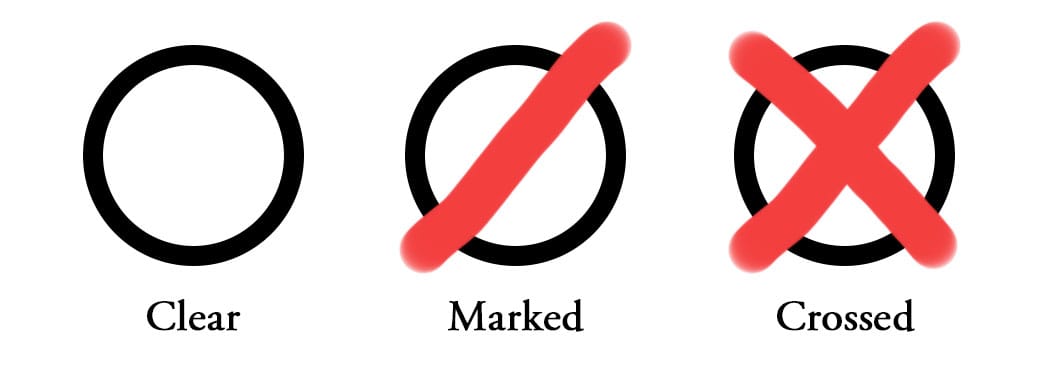Stats, Conditions, and Defying Danger in Dungeon World 2

Earlier this week, Helena wrote about The Problem with Hit Points in Dungeon World 1 and why we'll be using something else in DW2. One of our core aims in DW2 is to have the mechanics elevate character roleplay. This means inspiring exciting choices, easily assisting expression, and prioritizing narrative cohesion over mechanical limitations. We want to put you on stage, but not trap you in a box. Here is how we hope to do that.
Stats That Evoke Characters
What does a character's Strength stat mean? Sure, maybe it decides much they lift, how hard they hit, and how high they jump, but what does it mean about them as a person? It doesn't mean much. You could decide how their Strength affects their history, appearance, or behavior, but the stats themselves don't really help with that, nor do they describe anything beyond cold capability.
So we've decided to part ways with Strength and the rest of the D&D stats. They're great for other games, but for the character-centric focus of DW2 they aren't quite right. Dungeon World 2's stats are evocative adjectives that more directly influence how one might look, feel, and act. Here is what we've come up with:
- Forceful can mean pushy, stubborn, loud, dangerous, intimidating, or violent. A Forceful character is good at hurting others and getting them out of the way.
- Slippery can mean deceptive, quiet, flexible, quick, precise, or elusive. A Slippery character is good at navigating situations and environments quickly and stealthily.
- Astute can mean careful, clever, vigilant, educated, skeptical, or paranoid. An Astute character is good at noticing subtleties and deducing truths.
- Intuitive can mean sensitive, spiritual, instinctive, imaginative, or empathetic. An Intuitive character is good at reading people and communing with the supernatural.
- Compelling can mean alluring, confident, prestigious, eloquent, or mysterious. A Compelling character is good at influencing people and getting noticed.
We hope these stats and the terms we've chosen will help DW2 characters simultaneously feel like real people and larger-than-life adventurers. There's another aspect to all our favorite characters in media though - how do they act when things go bad?
Conditions That Prompt Responses
Conditions don't represent damage or harm directly, but instead convey how getting hurt can affect how a character feels, what they can do, and how they act. The five conditions each adventurer can suffer are Angry, Embarrassed, Injured, Panicked, and Sickened. Each condition gives you a penalty to an associated stat. Getting Injured makes it more difficult to be Forceful, for example, but there are several ways to push past this alone or with an ally.
When a character takes a condition, they choose an empty one listed on their sheet and mark it. Each condition asks a few questions about what caused it, what it looks like, and how the character acts now that they have it. Rather than directly stating the answers, the player is asked to consider these questions as they play to better assimilate the condition into the narrative.
While battle is the most obvious and common way to inflict a condition, it can also be a consequence outside of a fight. A few well-placed words can hit someone harder than any hammer, after all, and any tense situation can cause emotions to flair up unexpectedly.
So how do you deal with conditions when you have them? Resting and camping together is a staple of adventure fantasy, but it rarely makes sense to wake up freshly healed the next morning. How do we bridge that gap?
Recovery Both Classical and Sensible
If you want to remove a condition, you first need to do something in the fiction to address it. If you're Injured maybe you treat your wounds, or if you're Angry maybe you vent your feelings or start a fight. Each condition lists several example ways it could be dealt with.
Another way to deal with a condition is to ask for help from a friend. Actively helping a fellow adventurer, offering them sympathy or advice, or just being there for them can help them and also maybe yourself feel better.
Either way, when a condition has been dealt with, you don't erase it immediately. Instead you change it from marked to crossed. Crossed conditions still affect your rolls, at least for now.

Once you all Relax Together, all crossed conditions are erased, but marked conditions remain. Relax Together specifically sets out some time for the adventurers to talk with each other or do mundane activities together in order to help each other through conditions or for other purposes - though if they're in a dangerous position the GM might interrupt them with a threat.
There are also three more conditions: Bickering, Hopeless, and Hunted. Rather than affecting an individual, these group conditions each affect the entire party in unique ways. Group conditions are marked and crossed the same way as personal ones, but are slightly more costly to erase. We'll touch more on group mechanics in a future post.
There's one more aspect to harm and conditions that hasn't been mentioned yet. How do you stop it from happening?
The Necessity and Problem of Defy Danger
Defy Danger has always been a contentious move in the Dungeon World community, let alone PbtA at large. The move acts as a 'one size fits all' solution, allowing the full variety of fantasy adventure possibilities while maintaining feelings of both risk and competence. However, as time went on and PbtA's strengths and weaknesses were better understood by the community, Defy Danger seemed to embody few of the former and several of the latter.
Defy Danger is unclear on how it affects the fiction. The wording of what happens on a 7-9 is so ambiguous that the GM has almost nothing to work with. Its vague trigger means it's extremely easy to roll when nothing is at stake, or when something acts against the adventurers rather, than the adventurers acting themselves. An experienced GM can use Defy Danger as a stepping stone to great stories, but an inexperienced GM can very easily trip on it.
So we went with something else for Dungeon World 2. We still wanted to maintain the feeling of competency when dealing with almost any kind of threat, but we didn't want to slow scenes down with extra rolls or complications. The other moves will handle those plenty.
Resisting Consequences Concretely Yet Quickly
When you want to overcome an obstacle, avoid a consequence, or prevent harm, the first thing you do is say 'no'. This could be a severe consequence from a 6- result, or a potential threat warned about by the GM if you go through with something, or a danger happening to someone else nearby.
The second thing is say how you stop the consequence. What do you do in the narrative? You probably want to consider the next step while you do this one.
The last thing you do is spend Resistance, which is group of meta-currencies each adventurer has. There is one type of Resistance per stat, meaning there is Forceful Resistance, Slippery Resistance, Astute Resistance, etc. Choose which stat best fits what you described, and spend 1 of its Resistance.
No rolls, no uncertainty, no immediate risk. You say no, say how, and spend Resistance, then the consequence just doesn't happen.
Resistances have limits of course. You don't have that much of it to start with, and it usually only refreshes when you Relax Together. If multiple consequences occur simultaneously, you can only Resist one at a time. Additionally, group conditions must be resisted by two adventurers at once.
Altogether this means that Resisting something is a meaningful and powerful choice. Resisting something right now often means you can't Resist something else later. Those that want to optimize their Resistances will often have to stretch their imagination to find ways to believably describe how Intuitive helps against throwing knives. That's a feature of this mechanic, not a bug!
We intend Resistance to provide a clean and fast way to show what the adventurers are capable of without putting creative load on the GM or slowing down the game with extra rolls.
The Legacy of Dungeon World
Some people are not happy with how different from its predecessor DW2 is already shaping up to be, while others are excited for it. Dungeon World was a monumental game when it game out, opening doors for so many people to new games and systems. We want to honor that by taking another step forward in the direction it was headed. We don't want to leave DW1 behind, but instead have this game come alongside and complement it. To that end, we intend many parts of DW2 to be usable in DW1 as well. A rising tide lifts all boats, and we want DW2 to lift up Dungeon World and game inspired by it like Stonetop, Freebooters on the Frontier, Adventure World, and so many more.
Everything in this and future posts is still subject to change. Playtesting is going well, but refinement is still ongoing. As an example, a few weeks ago we reduced the number of group conditions from five to three. Some of what we said above will probably change before DW2 is finished.
That's all for now, watch for next weeks posts on dice and group mechanics in Dungeon World 2.
